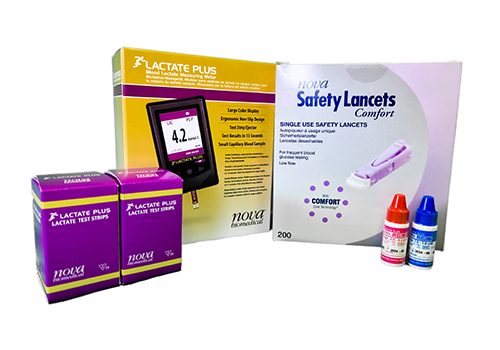Knowledge Hub
Blood Lactate Monitoring Solutions in Medical, Fitness, Sports & Academia
Monitoring blood lactate levels is a common procedure across the medical, fitness, sports and academic fields as an indication of your health and fitness.
Our article on blood lactate and lactic acidosis provided a look at what lactate is. To recap, we explained that:
Lactate is a bi-product of metabolism and exercise. When your lactate production exceeds your body’s rate of removal (most commonly during intense exercise), its concentration in the blood increases. Resting blood lactate levels usually range from 1-2 mmol/L, but during intense exertion, they can exceed 20 mmol/L.
Monitoring blood lactate is crucial for understanding your lactate threshold and physical limitations, as well as general health – it can help prevent lactic acidosis-related complications.
Here, we continue the conversation on blood lactate – including monitoring your blood lactate and the many benefits of doing so.
Medical Applications
One of the most obvious applications for lactate monitoring is within the medical field. A blood lactate monitor can provide insights into various conditions which may affect, or be affected by, lactate levels.
For example, lactate levels can be affected by certain medications and medical conditions; this includes Metformin, a medication for Type 2 diabetes, and conditions like kidney and liver disease as well as some cancers.
High blood lactate levels can indicate conditions such as ischemia or hypoxemia, allowing for early detection and appropriate treatment.
Additionally, blood lactate monitoring is closely associated with diagnosing and managing sepsis, also known as blood poisoning. Lactate levels can indicate the severity of the illness and offer insight about treatment options.
Fitness and Sports Applications
Monitoring blood lactate levels has proven to be an invaluable tool for professional athletes and fitness enthusiasts.
In this application, testing allows athletes to optimise exercise intensity and track their progress and improvements in physical performance. By measuring blood lactate levels during exercise, individuals can determine their lactate threshold, which is the intensity at which lactate accumulates in the blood. In endurance performance, for example, having a high lactate threshold is particularly important.
This information is crucial for athletes as it helps them understand their physical limits and avoid injury. Additionally, monitoring blood lactate levels can help prevent lactic acidosis-related complications, a condition caused by excessive blood lactate accumulation.
In practice, this means that athletes can train at peak efficiency by stressing the body correctly for a desired outcome, or compete at an intensity that prevents fatigue and ensures a strong finish.
Academic and Research Applications
Blood lactate monitoring also helps researchers and academics to develop their understanding and studies surrounding physiological responses of patients and athletes during exercise.
This can help future discoveries, including optimised training protocols, medical technologies and treatment strategies, as well as targeted interventions for specific populations.
Testing can also be used for demonstrative purposes within educational facilities, contributing to students’ wider understanding of this field.
Blood Lactate Monitoring Systems
Blood lactate monitoring solutions are equipped with the essential features to carry out lactate monitoring, including:
- A lactate meter, which reads the blood sample and displays results.
- Lactate test strips - single-use devices, used to hold the blood sample and insert it into the meter.
- Lactate control solutions that validate the system’s accuracy with control tests. Level 1 is used for a normal measurement range verification (1.0 – 1.6mM). For high measurement range verification, the lactate control solution level 2 is available (4.0 – 5.4mM).
- Safety lancets, allowing for easy and safe blood sampling from the fingertip or earlobe.
There are several different blood lactate meters available on the market. For example, the Lactate Plus Meter is a handheld device which is appropriate for both indoor and outdoor applications with an easy-to-read, colour display. The meter automatically stores measurements, with the capacity to hold 130 measurements across 10 user profiles.
When comparing lactate meters, you may consider the price of the kit, the measurement time, measurement range, memory capacity, altitude limit, and weight of the meter. Blood sample size is a particularly important factor; the more blood required, the more painful and time consuming the collecting and analysing process is. Handily, the Lactate Plus meter is notable for its very small sample size requirement.

How to Use a Blood Lactate Monitoring System
You can measure blood lactate in the gym, in clinics and laboratories, as well as in outdoor environments in some cases. This process should be overseen by a competent tester for the most accurate results and can be taken in rest and during physical exertion.
Before beginning a blood lactate test, the tester should ensure they’re wearing sterile gloves in order to perform the test. The area which is to be pricked by the lancet should also be cleaned.
Before beginning a blood lactate test, it is best practice to wear sterile gloves and have a dedicated sharps bin to discard used lancets and test strips. Alcohol wipes should be used to prepare the collection site.
The athlete or patient can begin exercising, whether running on a treadmill or cycling. During the exercise, the lancet is used to prick your finger or earlobe to produce a drop of blood. Testing can be completed at intervals throughout the whole exercise – this is known as a step test, and allows the athlete or patient to be tested at a range of intensities for a complete profile.
When blood is produced, it is important that the first drop is discarded, as it may contain contaminants; the second drop of blood produced by this prick can be placed on the test strip.
Insert the test strip into the meter and wait for the results to appear. Record the result; this can be used as needed as part of a medical document or training programme.
Insert the test strip into the meter, then place the end of the test strip onto the drop of blood, the sample will be drawn into the test strip by capillary action. After the results have appeared on the meter, make sure to record them for use as needed.
The result will appear as mmol/L (millimoles per litre). A normal reading at rest will typically be between 0.5 and 2.5 mmol/L; during physical exertion this can rise to over 20 mmol/L. A competent individual (such as a nurse, doctor, or sports coach) can help you interpret the results of the test.
After the test, discard used test strips by using the ejection button on the back of the meter into the sharps bin and disinfect the equipment for future use. You can reach out to Cranlea's support team if you have any questions or concerns about using your lactate monitoring system.
Conclusion
Whether you're a professional athlete, fitness enthusiast, medical patient, or researcher, keeping track of your blood lactate levels can help you understand and improve your health, optimise your performance, and prevent complications associated with lactic acidosis.
Cranlea Human Performance’s reliable and accurate blood lactate monitoring solutions enable you to easily monitor your blood lactate levels to do so, so that you can benefit from a greater understanding of your physiological health.
Related Articles
Discover more expert guides
Speak to the experts
Got a question?


